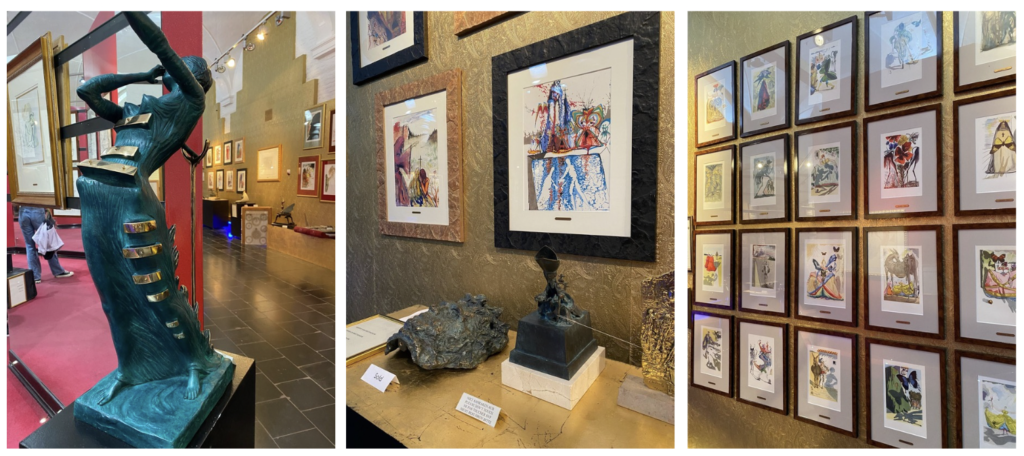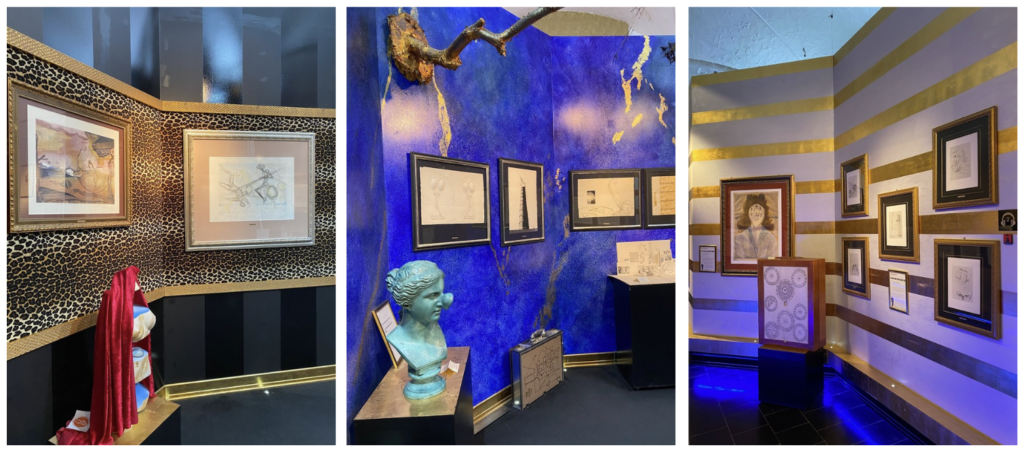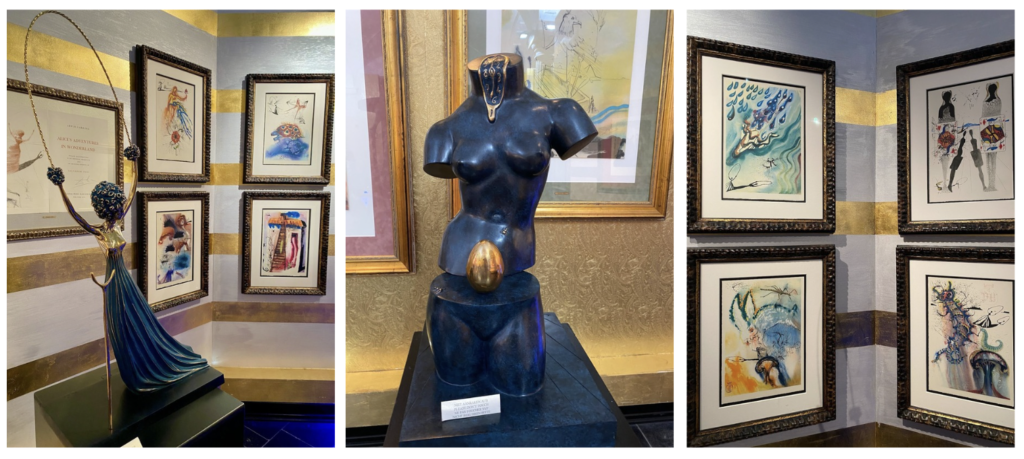Stepping into the Salvador Dalí Exhibition in Bruges was like being transported into a realm where the boundaries between dream and reality, the conscious and unconscious, blur beyond recognition. The exhibition immerses visitors in Salvador Dalí’s mysterious vision, offering a rich sensory experience. It features rare works, including 3D art, design pieces, vibrant glass sculptures, and the Daum collection. The exhibition resides within the medieval tower of the Belfry of Bruges that offers a breathtaking vantage point over the vibrant heart of the urban center. In the Market Square, where the majestic tower rises, the convergence of past and present unfolds in timeless harmony—a theme echoed by Dalí’s iconic melting clocks, which symbolize the fluidity of time itself.
Wandering through the curated rooms, each dedicated to a distinct period of Salvador Dalí’s life, I embarked on a journey through the contrasting microcosms of his artistic evolution, all brought to life by 300 works in a private collection. These spaces were imbued with profound artistic significance, while simultaneously echoing the innocence of Dalí’s childhood and world of paradoxes. In the gallery, imagination reigned supreme, and I felt myself becoming part of a complex interplay between reality and fantasy, woven into a grand creation that stands as a testament to Salvador Dalí’s extraordinary vision. His work, both shocking and thought-provoking, invites a deeper understanding to truly grasp its layered complexities—an experience made all the more accessible through the unique storytelling of the audio guides. In this article, I will become your personal guide through the captivating universe of Dalí’s museum, offering you my own perspective on the experience and sharing the works that left the deepest impression on me.

As a master of sensation and a visionary far beyond the realm of painting, Salvador Domingo Felipe Jacinto Dalí Domènech known as Salvador Dalí was not merely an artist, but an inventor of new ways to perceive the world. His childhood and the memories of his family played a pivotal role in shaping both his personality and his career, deeply influencing the development of his technique and his tendency toward certain obsessive motifs. Born in the Catalonian town of Figueres in northeastern Spain, Dalí inherited from his mother, Felipa Domènech Ferres, his creative spark.
The death of Dalí’s older brother, also named Salvador, at a young age had a profound impact on him, as his parents, in their grief, projected the image of the lost child onto him, shaping Dalí’s sense of identity and fueling his lifelong exploration of themes like duality, death, and the subconscious. In fact, the denial of his own individuality gave rise to the existence of an alter ego. As a result, Dalí became determined to assert his own uniqueness, deliberately accentuating his singular personality as a means of distinguishing himself from the shadow of the brother he was thought to embody.Dalí’s ability to create visual illusions by juxtaposing sharp, detailed images with soft, flowing contours within a single ambiguous scene can be seen as a reflection of his complex sense of identity, the tension between the two selves—the one he was expected to be, and the one he truly was.
Moreover, central to Dalí’s work is his exploration of the unconscious, a theme that resonates throughout his entire body of work. Influenced heavily by the theories of Sigmund Freud and psychoanalysis, Dalí was obsessed with uncovering the hidden, darker aspects of human consciousness. His art functions as a mirror to the subconscious, exposing the most obscure and repressed thoughts and emotions.
Upon entering Dalí’s universe, one is immediately enveloped in a golden world, where every detail seems infused with the richness of nature—leaves cascade and the viewer is compelled to grant Dalí’s works the attention they rightfully deserve. At the same time, the bold choice to challenge and provoke the viewer carries multiple layers of meaning, inviting various interpretations. In Dalí’s surrealist world, gold can be seen as a means of elevating his subjects to a mythological or transcendent level. For instance, in works like “The Sacrament of the Last Supper” (1955), Dalí uses gold to evoke divine light or spiritual significance, most notably with the golden sphere hovering above Christ’s head. Additionally, gold can also be viewed as a representation of narcissism in the Freudian sense, as exemplified in his work “The Metamorphosis of Narcissus”, where the shimmering gold accentuates the obsessive self-absorption that defines the myth of Narcissus.

Among the masterpieces on display was his iconic “The Persistence of Memory”, a profound example of Dalí’s genius in transforming the irrational into tangible form, where time itself appears to melt, bending and warping in ways that defy both logic and the laws of physics. “The Burning Giraffe” (1937) struck me as a profound reflection of Dalí’s inner turmoil and the disintegration of identity. The juxtaposition of surreal, almost clinical detail with haunting symbolism created a feeling of profound unease. The figures, distorted and fragmented, evoked a sense of vulnerability and alienation. The crutch-like supports and the rawness of exposed muscle beneath the skin seemed to suggest a fragile existence. In the distance, the giraffe, set aflame, felt like an omen—a premonition of a world spiraling into chaos. Dalí described it as a “masculine cosmic apocalyptic monster,” and standing before it, I couldn’t help but feel the weight of impending disaster, both personal and global, seeping through the canvas.
One exhibit that stood in stark contrast to the rest of the show was Dalí’s interpretation of “Alice’s Adventures in Wonderland.”
Here, the colors softened, taking on the hues of childhood innocence and gentleness, yet Dalí’s unmistakable style was ever-present, transforming a seemingly simple tale into a dreamlike and bizarre experience. The collaboration between Dalí and the visionary editor at Random House was a union of two worlds. In the early 1960s, Dalí was commissioned to illustrate an exclusive edition of Carroll’s “Alice”, producing twelve heliogravures, including a frontispiece signed in each copy of the limited edition. Each chapter came alive in Dalí’s hands—whether it was “The Pool of Tears,” “The Caucus Race and a Long Tale,” or “Advice From a Caterpillar,” the illustrations transcended mere depictions. Infused with his signature techniques, Dalí’s illustrations for Alice were not just artistic renditions but an exercise in surrealism. For the character of Alice, he reused an image of a girl skipping rope, a figure he had first painted over thirty years earlier. This strange, static, mid-motion figure—almost like an icon—echoed the technique of automatic drawing and the cut-up method. It felt as if Dalí were channeling Lewis Carroll’s incantation from the first page: “The rest next time—”, making the story feel like an ongoing dream, just as the famous refrain, “It is next time!” would suggest.
In this realm of painting I discovered Dalí’s exploration of the unconscious that extended to his sculptural vision as well. His bronze figures, elongated and distorted, are not merely representations of the human form; they are symbols of the tension between the real and the imagined. His technique is based on the creation of a wax model used to make a mold, in which to pour molten bronze.
One of the most striking elements was his reinterpretation of recurring images, such as the elephant bearing an obelisk from his painting “The Temptation of St. Anthony”, which reappears in the sculpture “Space Elephant”. The exaggerated, spindly legs of the elephant, extending impossibly toward the sky and meeting the massive weight of its body, create a surreal, almost dizzying effect . This disproportionate form was a deliberate manipulation of space and time, evoking a world where these concepts are suspended, disordered, and metaphysically unbalanced. The elongation of the elephant’s legs, it seems, symbolizes humanity’s longing to reach the unknown, to stretch toward knowledge — a constant pursuit of the unattainable.

Among the other mythical creatures that Dalí immortalized in his sculptures, the unicorn stands out. In “The Unicorn” sculpture, Dalí eulogizes his love for his wife, Gala, using the heart-shaped opening in the wall as a powerful symbol of their bond. The unicorn, a creature steeped in myth and legend, is universally recognized as a symbol of purity, with its horn believed to possess the power to neutralize poison. In Dalí’s sculpture, the unicorn’s horn pierces the wall, sending blood dripping from the heart-shaped wound, a striking representation of both sacrifice and passion. This sculpture becomes a multifaceted synthesis: the symbolism of the bleeding heart, the wall as a barrier, and the powerful presence of the unicorn all converge to convey Dalí’s deep affection for Gala.
Dalí’s world is a place where myth and personal identity intertwine, turning love into a universal, timeless symbol. My visit to “Dalí’s Universe” at the “Dalí Museum” in Bruges wasn’t just about admiring his work—it was a journey into the surreal, where logic fades and imagination reigns. The haunting, desert-like landscapes that reappear throughout his pieces invite you to explore deeper meanings, challenging both the mind and spirit. For anyone seeking a unique, transformative experience, Dalí’s universe offers an invitation to step beyond the ordinary and into the extraordinary. If you’re looking for a glimpse into the mind of one of the most inventive artists in history, this is a place you simply can’t miss.
Other posts that may interest you:
Discover more from The Sundial Press
Subscribe to get the latest posts sent to your email.





